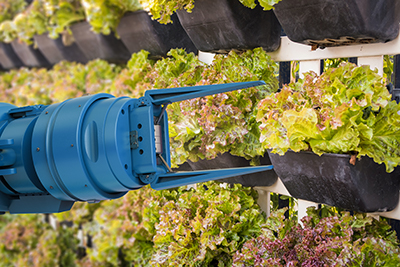
What Is Computer Vision?
Computer vision is a technology that allows computers to gain a high-level understanding from images or videos. Then, machines use that understanding to complete tasks that the human eye does.
What Is the Vegebot?
The Vegebot was invented and tested by a team of researchers at the University of Cambridge. It is made up of three primary pieces of technology. Those pieces are a computer vision system, a cutting arm, and a gripping arm. The Vegebot was developed to streamline the produce cutting process.
Keep reading to learn how the Vegetbot works, how it is improving lettuce harvesting and some predictions for the agricultural industry’s future.
How Does the Vegebot Work?
The Vegebot works by using its overhead machine vision camera to identify all of the lettuce within its field of view. It then analyzes each piece of lettuce and determines whether it is healthy enough and ripe enough to harvest. Once it finds a piece of lettuce that meets both of those criteria, it carefully and precisely cuts the desirable lettuce from the rest of the plant so that it is ready to be sold at the supermarket.
To ensure Vegebot consistently selected the right pieces of lettuce, the Vegebot research team had to develop a machine learning algorithm using many images of various kinds of lettuce and train the robot based on that algorithm. To prove this algorithm was effective, Vegeobot first had to identify and cut the correct lettuce in the lab and then do so in the field under multiple weather conditions.
Once the Vegebot has selected a healthy piece of lettuce, the second camera near the blade helps to ensure the cut is smooth and no extra undesirable pieces are hanging on.
Though it may not seem so at first, Vegebot’s gripping arm is also key to its success. The firmness of its grip had to be perfected so that it held the lettuce firmly enough to not drop it but softly enough, so the plant was not crushed. The force of the gripping arm can be adjusted based on the type of produce it is picking and cutting.
How It Improves Lettuce Harvesting
The Vegebot improves harvesting by making it safer for those picking and for the consumer. Those picking no longer have to use sharp blades and risk the chance of accidentally cutting themselves, and because the Vegebot is a robot, it can significantly reduce the chances of a salmonella outbreak.
This technology also makes harvesting more efficient. The Vegebot does not get tired or distracted, can work through the night, and can select healthy lettuce with as much accuracy as a human harvester.
Possibilities for the Future
Currently, the Vegebot cannot harvest at the speed of an experienced human harvester. But with continued research, it has the potential to do so. In addition, farmers hope that, in time, robotic farming solutions, like Vegebot, can help offset the agriculture industry’s labor shortages. Right now, slowing immigration numbers and a lack of interest in agriculture jobs are creating a growing need for harvesters in the United States.
It is projected that Vegebot and similar harvesting solutions will also be able to reduce food waste. Today, fields are typically harvested once, and unripe fruits and vegetables are thrown away. However, Vegebot could perform multiple passes on a field and harvest any ripe vegetables that were not ready on the first pass.
Ready to find the right camera for your computer vision project? Browse our broad selection of cameras from today’s leading manufacturers.
